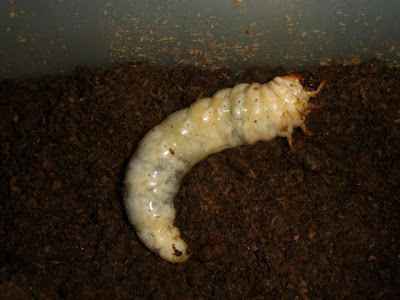I bought four P. muelleri L3 larvae on October 16th 2010 .
The weight of the larvae was 3 grams , 6 grams , 6 grams and 7 grams .
I had fermented some decayed wood flakes before buying them , so i employed the wood flakes to feed them .
The larvae were put in plastic containers , the volume of the containers is about 1 liter .
Through the transparent containers i could observe the larvae clearly .
2010-11-19 , i found that the larvae consumed the wood flakes very fast , so i decided to change the wood flakes .
2010-11-20 , i changed the wood flakes and weighed the larvae at the same time , their weight was 11 gram , 13 grams , 9 grams and 13 grams respectively .
At that time , the larve had started to store fat , the fat inside their bodies was white in the beginning , as time goes on , much fat would be stored in their bodies , when they approached to build pupal cells , they were opaque and yellow in color , signifying that they achieved maximum weight , at that moment , the weight would not increase quickly .
2010-12-11 , One of the larvae was dead , the weight of the rest larvae was 14 gram , 16 gram , X , 16 gram .
2011-1-21 , Their weight was 16 grams , 18 grams and 19 grams .
2011-2-28 , i discovered a pre-pupa .
2011-3-16 , the individual became a pupa .
2011-3-19 , i discovered the second pupa .
2011-3-21 , the last larva was in the pre-pupal period .
2011-3-23 , the last individual had pupated .
The larvae were males , their pupae all had obvious mandibles .
The first pupa turned into an adult on April 16th 2011 , i let him stay in the original pupal cell , because the conditions of the cell was well .
Another two pupae had been taken out of the pupal cells , i put them in artificial cells , finally , they turned into the adults on April 21st 2011 and April 23rd 2011 respectively .
This time , i had used fermented decayed wood flakes to raise the larvae at the room temperature , i found that the wood flakes decayed quickly when the rearing temperature was high , once the rearing humidity was also high , the wood flakes would become dirt quickly .
In order to prevent the condition , i would decrease the rearing humidity or keep the containers in cool places .
In Taiwan , the beetle breeders usually use kinshi bottles to raise rainbow stag beetles and have gained many good efforts .
Once choosing kinshi bottles to rear P. muelleri larvae , the temperature control is necessary , because the temperature inside the bottle was higher than the room temperature , when the fungi decompose the lignin , the temperature would rise within 1 ~ 5 degrees Celsius .
P. muelleri larvae and adults all have amazing look , i personally suggest you to experience the species in person .
Related pictures :
 |
| The larva ate the wood flakes alone with his excrement pellets |
 |
| P. muelleri L3 larva , 9 grams , 2010-11-20 |
 |
| P. muelleri L3 larva , 13 grams , 2010-11-20 |
 |
| The larva started to store fat , 2010-11-20 |
 |
| P. muelleri old L3 larva , 18 grams , 2011-1-21 |
 |
| P. muelleri old L3 larva , 19 grams , 2011-1-21 |
 |
| P. muelleri old L3 larva , 16 grams , 2011-1-21 |
 |
| P. muelleri pre-pupa , 2011-2-28 |
 |
| P. muelleri male pupa , 2011-3-16 |
 |
| P. muelleri pre-pupa , it would pupate in two days later , 2011-3-21 |
 |
| Above individual had pupated , 2011-3-23 |
 |
| P. muelleri male pupa |
 |
| It was time to start eclosion |
 |
| Starting to spin his body , 2011-4-16 |
 |
| To dry out his inner wings |
 |
| Starting to stretch his mandibles |
 |
| The eclosion was over |
Another individual :
 |
|

























































